How To Play Lost Island

What is “Lost Island”
Lost Island is a storytelling game in which we take on the role of people who find themselves the sole survivors after a tragic plane crash on a deserted island.
The game is strongly based on the series “Lost”, the books “Lord of the Flies”, “Robinson Crusoe” and “The Island of Dr. Moreau”. In turn, we ask and answer questions, and thus tell the adventure of our small group.
We can imagine the story we are telling as a self-contained season of a television series. Both in terms of the tone and the actual events. Whatever we like, we let become part of the story. Cinematic logic always takes precedence over realism. An exciting, emotional story always precedes constrained continuity.
The game is designed for 3 to 6 players.
The playing time depends strongly on the respective group. However, three hours has proven to be a good benchmark.

Before we get started
Safety Tools
All of us want to have a good time together, so we look out for each other and make sure that everyone feels comfortable. We do this by looking at each other’s facial expressions and body language, or by specifically asking if everyone is doing well and having fun.
In order to create an atmosphere that allows everyone to participate openly and freely in our game, in our story, we talk before the start of the game about which so-called safety tools we want to use.
There are very good summaries of the different techniques, e.g. in the following Document from the 3W6 Community or in this article Security Techniques in Pen & Paper Roleplaying by Tina Trillitzsch. Each with sources and further links to delve deeper into the topic. There is also a very useful article about safety tools at www.dramadice.com.
Recommended tools are:
- Open Door Policy
- Lines & Veils
- X-Card
Breaks
As much fun as we have playing, it’s more exhausting than you think to actively listen and creatively participate. That’s why we make sure to take regular breaks; to take a short breather and then dive back into the story with renewed concentration.
Play materials and setup
Playing aids
Before we can get started, we need to prepare the game materials for our game. For this we need the downloaded .pcio file to load the game table and cards at https://playingcards.io. In addition, we can make a copy of the so-called Character Keeper in advance via Google Sheets, which we will use to create our characters.
Preferably we play via a video chat tool of our choice. For instance, without registration, this is possible using Jitsi Meet.
The .pcio file contains the following cards:
- X-Card (1 Stk)
- Endcard “A ship emerges from the dense morning fog in front of the island. Finally the longed-for salvation? What from the island will accompany you all your life?” (1 Stk)
- Draw an event or mystery card (11 Stk)
- Prompt cards (36 Stk)
- Mystery cards (15 Stk)
- Event cards (14 Stk)
- Status cards (4 Stk)
- Unity
- Knowledge
- Safety
- Supply
Setup playingcrads.io
The basic setup on https://playingcards.io has already been done for us. So we only have to upload the previously downloaded .pcio file to https://playingcards.io by scrolling down to the “Import a Game File” button on the home page.

On the following screen, we drag our .pcio file into the field provided.

We will see our room name after the upload, which we can share with all the players via the displayed room name (top right).
By clicking Enter we can join the game and complete our preparations.
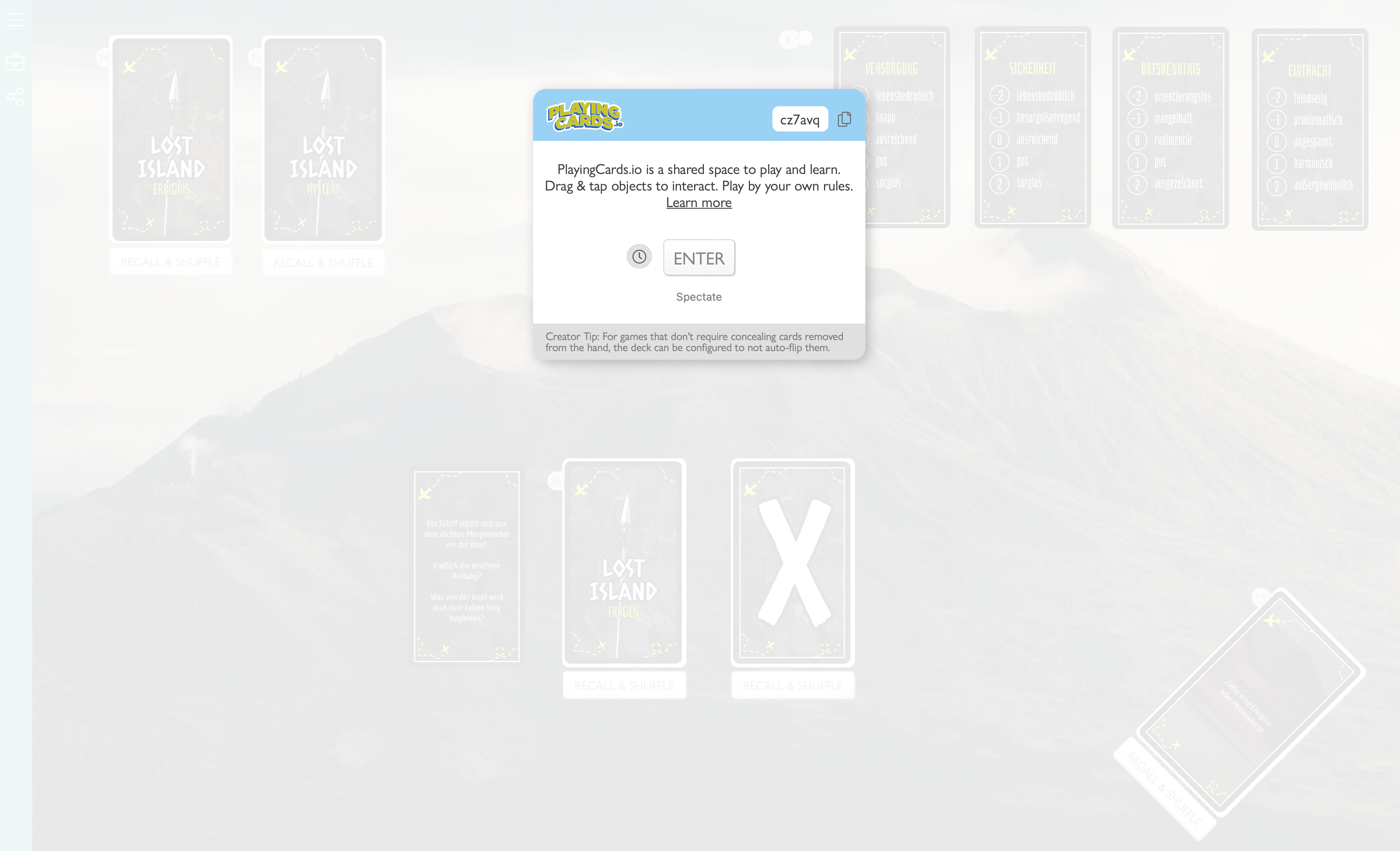
With “RECALL & SHUFFLE” we shuffle all prompt, event and mystery cards once before the start of the game.
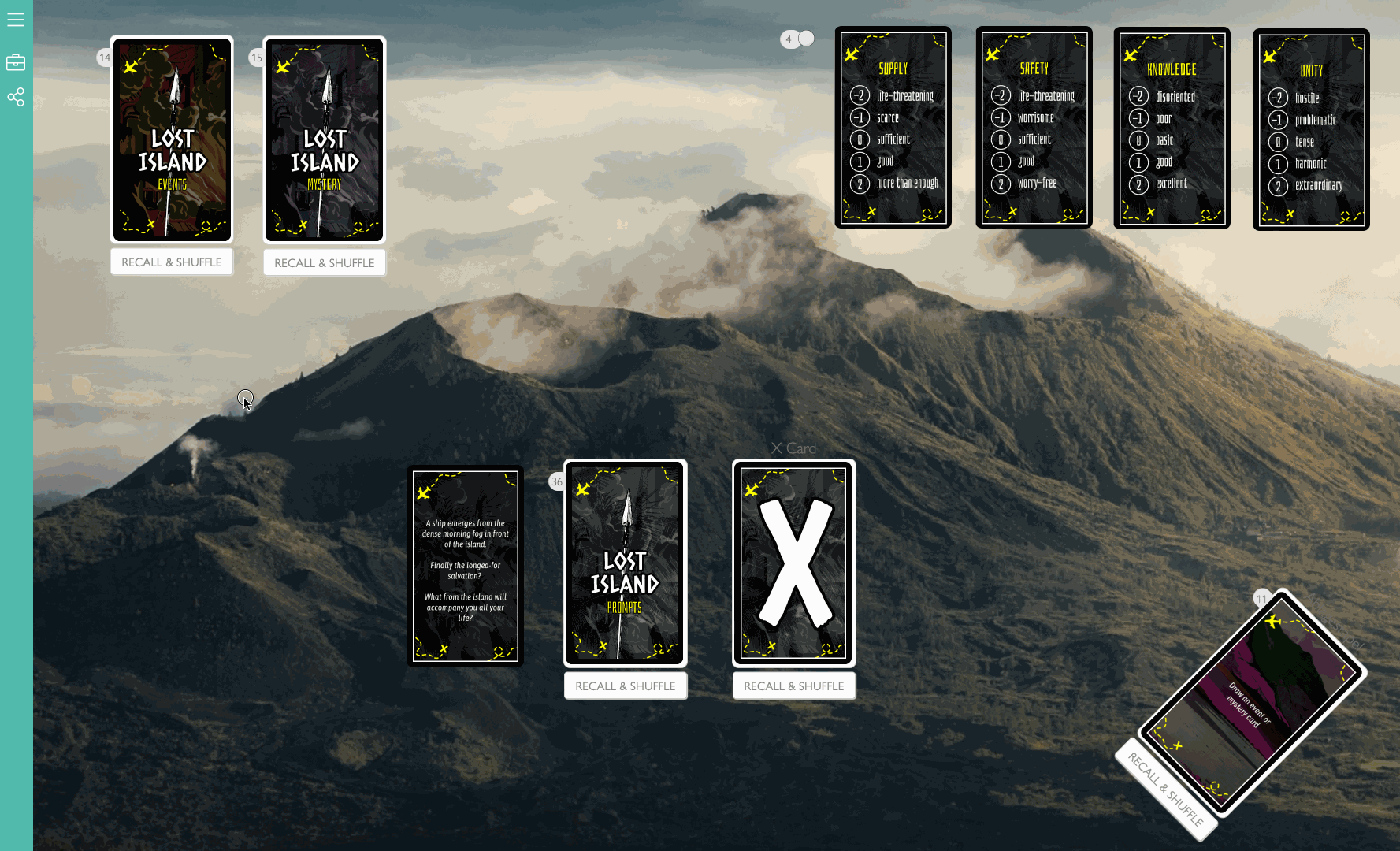
Next, we left-click on the number in the upper left corner of the Prompt Card Stack (the cards with “PROMPTS” printed on the back). In the context menu that appears, we define how many questions we want to answer in this game. In doing so, we adjust the number to the desired game length.
For 3 to 4 players, 11 prompt cards have proven to be a good starting point. For 5 to 6 players, 16 cards are recommended. We place the slider so that the desired number is displayed and click “Cut Deck”.
We drag the pile with the desired number of prompt cards with a left click on the number slightly upwards onto the free space above the divided pile. The unused prompt cards can be put aside as a draw pile.

We do the same with the “Draw an Event or Mystery Card “ cards. We recommend 5 cards for 3 to 4 players and 7 cards for 5 to 6 players. We click on “RECALL & SHUFFLE” once to turn the deck over and then split the stack at the desired number of cards.
Then we drag this stack onto the previously prepared prompt card stack, while rotating it by clicking on the letter “Z” so that it is oriented in the same way as the prompt cards.

Once again, we left-click on the number in the top left corner of the card stack and select “Shuffle Stack” to shuffle the questions again.

Afterwards, we click once on the End Card, to flip it. Then we drag it back to the center of the table. The last thing we do is move the shuffled prompt card pile onto the End Card.

The Character Keeper
Together we now create our characters via the Character Keeper.
For this we first define the language and the desired game setting (see Optional Scenarios) via the corresponding dropdown in the upper left corner of the Keeper.
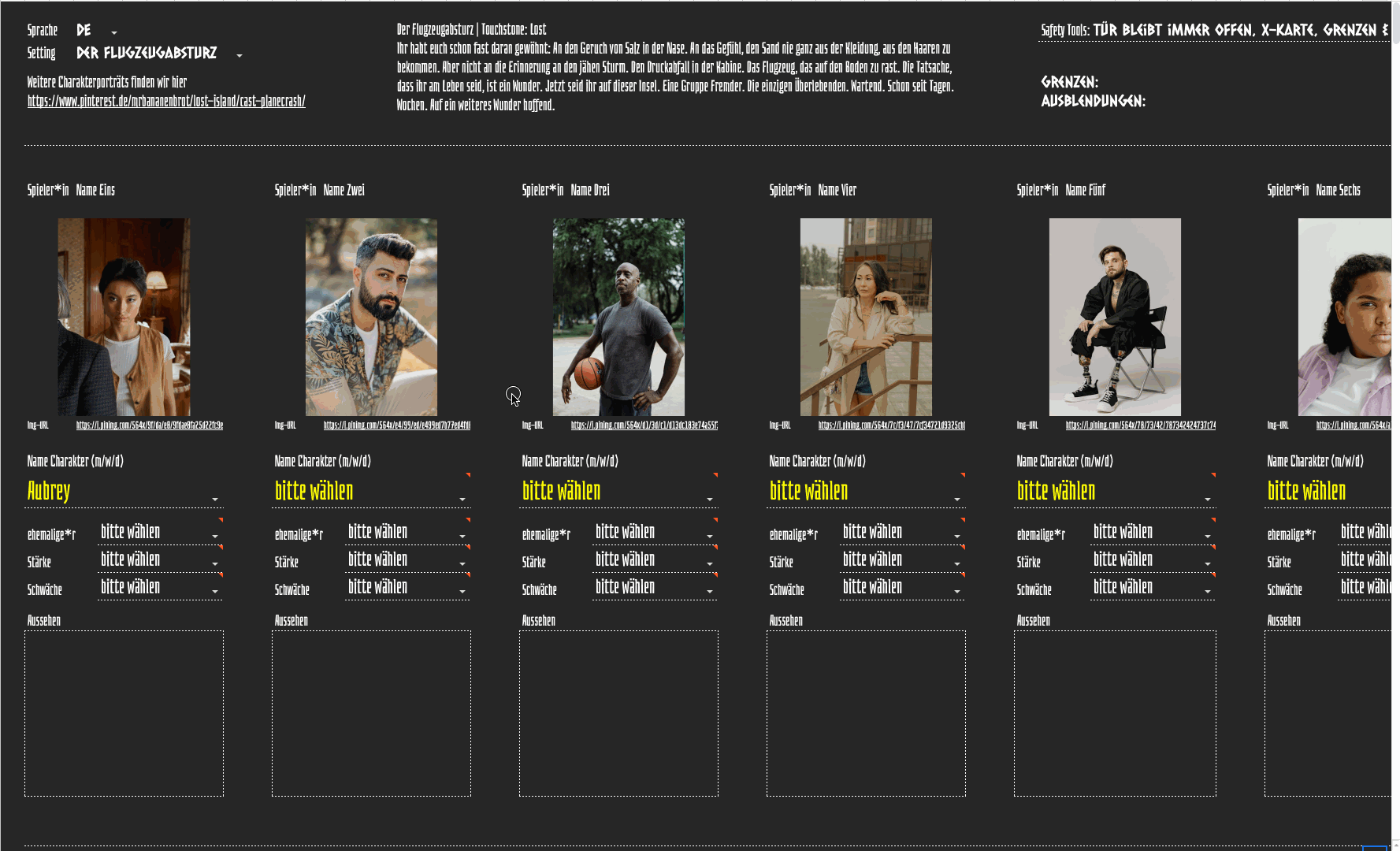
Also, now would be a great time to talk again about the safety techniques agreed upon and defining our lines & veils, and add them to the top right of the play aid.
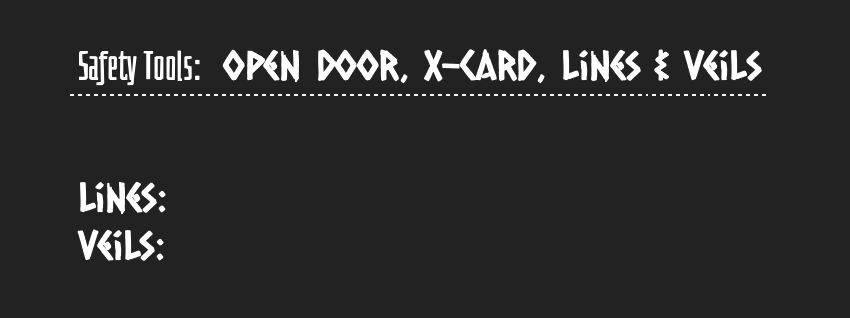
Getting Started. Playing Lost Island
The Cast
First we decide who will be the group of survivors who will be the main characters in our story. To do so, each person creates a so-called player character. Together, all the player characters then make up the cast of our story.
We create our characters collaboratively, discussing our choices and inspiring each other. That’s already all part of the game. We do not have to create our cast exactly in the order described below. If it’s easier for us to choose, for example, the past and the characteristics first and then choose a suitable image, of course we’ll do that. There is no wrong way to do it. We can record who we are in the provided Character Keepers.
Who am I?
The first thing we do is choose a character’s portrait. Here we can use, the Pinterest collection created for the game. Depending on our taste, we can also just describe our character with some words in the field provided for this purpose.
To change our character’s portrait, we copy the image URL by right-clicking on the desired photo, selecting the “Copy Image Address” option, and then pasting the address in the cell next to the one with label “Img URL”.

My past
Next, we determine what profession our character was pursuing before the plane crash. To do this, we select an occupation from the dropdown next to the cell labeled “former”.
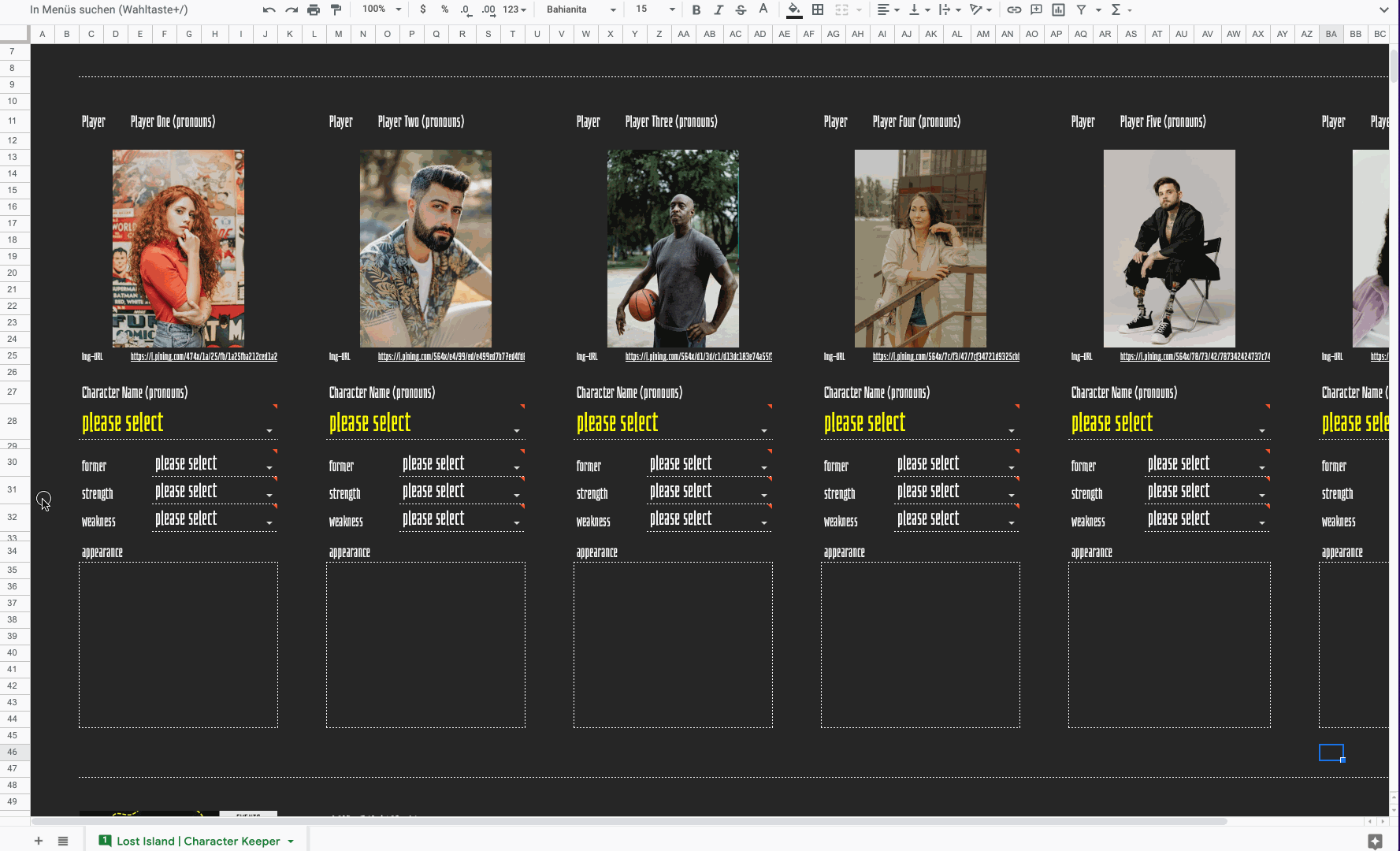
If we want to randomly pick a profession, we can roll two six-sided dice - these are the standard dice of Yahtzee, or other board games - on the table below. The first result of the dice is the number of the row, the second result is the number of the column. With a 4 and a 2, we would have been a musician before the crash for example. This is how we can determine all of our character’s values, if we want to.
Our past and our characteristics should only give us a rough impression of ourselves - our character - and our group. A stepping stone, so to speak, into our story. Who our characters are “now” and how they react to the dramatic situation of the disaster, that we find out during the course of the game.
When choosing a profession, we can consider: Who or what had the greatest impact on me while I was doing my job? Was I successful? Have I been happy?
| 1 | 2 | 3 | 4 | 5 | 6 | |
|---|---|---|---|---|---|---|
| 1 | Engineer | Author | Student | Architect | Graphic Designer | Diplomat |
| 2 | Journalist | Pastor | Cook | Musician | Nutritionist | Letter Carrier |
| 3 | Pilot | Cab Driver | Teacher | Butcher | Lawyer/Attorney | Managing Director |
| 4 | Policeofficer | Bartender | Doctor/Physician | Surf Instructor | Educator | Tatoo Artist |
| 5 | Mechanic | Banker | Florist | Salesperson | Scientist | Interpreter |
| 6 | Accountant | Actor | Bike Courier | Farmer | Obstetrician | Pharmacist |
Hello, my name is
Of course, our character needs a name. We can choose one from the dropdown list or make up our own. Don’t waste time coming up with a last name, no one will address you with it. But your name is part of your past. Do you wear it with pride, or are you, in fact, happy to start over?
| 1 | 2 | 3 | 4 | 5 | 6 | |
|---|---|---|---|---|---|---|
| 1 | Haik | Aspen | Onive | Ash | Avery | Willow |
| 2 | Vio | Rook | Quinn | Alex | Brynn | Nova |
| 3 | Zia | Aubrey | Kay | Parker | Dyle | Ellis |
| 4 | Mauve | Clover | Thyme | Tayler | Ilya | Lev |
| 5 | Moon | Clio | Blair | Harper | Jae | Lean |
| 6 | Ember | Kim | Silver | Nova | Yam | Riley |
My strengths and weaknesses
In order to give our character a little more depth and to give us a better foundation when we answer the questions posed to us - that is, to our character -, we also determine what we were particularly good at “in the past” and what our great weakness was. Again, nothing is set in stone. If we have the feeling that we would like to change something later during the game - go ahead.
My strength
Choose a positive trait from the list, or think of one yourself. No one can be reduced to just one positive quality. It is just meant to provide you and your fellow players with something to guide you. Would your friends describe you with this trait, or would you describe yourself this way? What quality do you admire in others?
| 1 | 2 | 3 | 4 | 5 | 6 | |
|---|---|---|---|---|---|---|
| 1 | bold | confident | careful | honest | satisfied | versatile |
| 2 | reliable | friendly | persistent | committed | prudent | attentive |
| 3 | sincere | adventurous | reliable | loyal | conscientious | affectionate |
| 4 | ambitious | modest | competent | tenacious | creative | empathic |
| 5 | charming | helpful | brave | balancing | cultivated | athletic |
| 6 | good-natured | open to criticism | disciplined | relaxed | motivated | optimistic |
My weakness
Choose a weakness from the list, or think of one yourself. No one can be reduced to just one negative characteristic. It’s just meant to give you and the people you’re playing with something to guide you. Are you aware of your flaws, or are they only little quirks and people just need to get to know you better? What behavior do you find unbearable in others?
| 1 | 2 | 3 | 4 | 5 | 6 | |
|---|---|---|---|---|---|---|
| 1 | stubborn | grumpy | careless | deceitful | dissatisfied | pathetic |
| 2 | careless | headstrong | erratic | lazy | impulsive | arrogant |
| 3 | cold | suspicious | unreliable | distractible | pretentious | forgetful |
| 4 | over ambitious | pushy | incompetent | plaintive | hurt | dominating |
| 5 | shy | selfish | messy | nervous | disrespectful | careless |
| 6 | begrudging | quick-tempered | skeptical | anxious | bored | unathletic |
Short introductions
Now it’s time for us to introduce our characters to each other. A short, snappy description will do. Watching the intro of our series, what would the viewer see that best characterizes the person in question? Just a little insight into who the character was before the crash is enough. Everything else unfolds in the game.
Non-player characters
We assume that our characters are the only survivors of the disaster. But if we are only 3 or less players, it is recommended to create so-called non-player characters to increase our cast up to four or five people. This way we have a bit more choice later on when answering the prompts.
It’s enough if we simply establish a portrait, name, and past for the non-player characters. However, we can just as easily assign a strength and a weakness quickly at random.
Nevertheless, when answering the questions, it is advisable to include the characters of the other players if it makes sense and is possible. The non-player characters are rather the supporting cast in the background of our little series.
The Lost Island
In order for everyone to have the same idea of where we have landed, we will briefly talk about what our island is like. We, as players, will of course explore the island gradually during the game. But what would you see of our island in the obligatory drone shot during the title fade-in?
Did we crash on a tropical island with palm trees and a sandy beach? Or rather on a rocky, cliff-ridden small archipelago? What is the climate like at the moment?
For the first round, the classic tropical island is a good choice. Simply because most people will be able to relate to it directly.
I have put together a few pictures for our inspiration. These can be found via the following link.
Again, we don’t want to dwell too long on discussions and descriptions. We will soon find out what exactly awaits us on the island. But it is important that all participants have a similar picture in mind. The best way to do that is to talk about it.
If we want, we can record the results at the bottom of the Character Keeper.

The Camp
After we have a rough idea of our island, we still have to determine how our camp looks like at the beginning of the game. Whoever has seen the sea last may describe how our camp and the directly adjacent area looks like. Of course, everyone is allowed to contribute or ask questions based on this. Did we stay near the plane wreck or did we look for another place? Did we walk to the beach or more into the heart of the island? Did everyone agree with the decision? At the beginning of the game, we assume that about 6 weeks have passed since the accident.
The Status Cards
So now we will really get started with the actual game. I promise. What is left now is to briefly define the starting position of our protagonists. We do this with the status cards on the playingcards.io table.
The person to the left of the one who has just described the camp chooses one of the four status cards “Unity”, “Knowledge”, “Security” or “Supply” and answers the question printed on the back.
To do this, we click once on the corresponding card and read out the question on it.

Based on the given answer, we determine the status for the given category by placing one of the four markers, to the left of the status cards, on the corresponding number. For example, if we think that, based on the given answer, our supplies are rather scarce, then we would set the marker on the “Supply” card to “-1 | scarce”.

For the start we want to set one category to 0, one category to 1 and two categories to -1. So in total we have: -1, -1, 0 and 1.
Clockwise, we answer all four questions and are then ready to draw the first prompt. Tip: Now would be a good time to ask the other players if we would like to take a short break before we start the actual game.
The Status Cards have no further mechanical effect. They only serve to give us a common understanding of how our group is doing at the moment. Accordingly, the value can be adjusted up or down at any time if we feel our situation has improved or worsened in a category based on our answers to the questions asked.

Gameplay
Scenario Intro Text
We can read out the scenario text before the first question card is drawn, in order to familiarize ourselves once again with the scenario. It’s like a intro to the first episode of our series. We can find this text at the top center of the Character Keeper next to the name of the selected setting.
You’ve almost gotten used to it: The smell of salt in your nose. The feeling of never quite getting the sand out of your clothes, out of your hair. Yet not to the memory of the sudden storm. The pressure drop in the cabin. The plane racing toward the ground.
The fact that you are alive is a miracle. Now you’re on this island. A group of strangers. The only survivors. Waiting. For days. Weeks. Hoping for another miracle.
The Game Begins
Now - as promised - the actual game begins. The person to the left of the one who answered the last Status Card may draw the first Prompt Card. After that, we continue to draw in turn, always in a clockwise direction.
When it’s our turn, we draw a Prompt Card, by clicking on the top card of the prompt deck, turning it over. Then we read out the question presented.
Every player answers the question posed to them according to their own feelings - they are allowed and encouraged to improvise and listen to their own gut feeling. Each participant can ask questions about the given answer or make suggestions, but is not allowed to answer for the others. Each player decides for themselves whether they want to answer the question or not.
When a question addresses “you”, it always means the player character of the person who drew the question. If a card states a seating position, such as “the person to your left,” it always means the character of the person sitting next to you.
Our answers do not necessarily have to build on each other chronologically. As with series, films or books, we can work with flashbacks or time jumps to the future. Our story is welcome to feel like a TV series, which also consists of individual episodes and vignettes. The following also applies when answering the questions: film logic before realism. The more drama and interesting twists our story contains, the more entertaining it will be. The only important thing to keep in mind is that everyone agrees with the direction we’re taking.
Touch the X card if you don’t want a card or an answer to be part of the story. This removes that element from the game. We simply draw a new card after that. At any time, we may also “X” cards that we have drawn ourselves.
When it is our turn, we may also pass. We then pass the card imaginarily to the person we think is most qualified to answer the question and say, “I’d like to hear your answer to this question.” In this way, a question card can move from one person to the next until it is canceled out by the X card. By passing, however, we lose our spotlight for that round, and after answering the passed card, the player to our left draws the next prompt.
When we draw an “Draw an event or mystery card” card, we get to decide whether we want to draw a card from the event or mystery deck (if there is one). We then draw a card there and answer the presented question.
After answering the prompt, we can consider together whether a status - i.e. “unity”, “knowledge”, “security” or “supply” - has changed for the better or worse for our group. We can indicate this by moving the marker on the respective status card to an appropriate value.
We continue to answer, pass or use the X card until the card “A ship emerges from the dense morning fog in front of the island. Finally the longed-for salvation? What from the island will accompany you all your life?” is drawn. We all take turns answering the question one by one. After that, our little story ends and we say goodbye to our characters and say to our island.

Debriefing. Let our game conclude
To conclude our game, we can use a method by Lu Quade, namely “Stars and Wishes”. Here, each player in turn may name one thing that they found particularly outstanding. This can be particular ideas, scenes or even characters. Something that enriched today’s game and that we really liked.
When we’ve given each in turn our “star”, we’re invited to express our “wish” for the next time. What would we like to see next time? What could be done differently or better next time? Maybe we’d like to explore the characters’ relationships even more? Or make our characters’ lives a little more dramatic with our answers next time?
This way we can review our game, our story and find a nice ending for our visit to our “Lost Island”.
An interesting article on Stars and Wishes can also be found at Burn After Running: RPG One-Shots.

Optional Rules
Nachfolgend sind ein paar optionale Regeln aufgeführt, die wir bei unserem Spiel nutzen können ‒ wenn wir möchten.
The map
If we like, we can record our experiences on a map of our island. This way we have a nice souvenir for our group after the game. We can choose one of the maps available here or draw one ourselves on a blank sheet of paper.
Optional Scenarios
To get some variety in our game, we can opt for a slightly different starting situation. You can find two examples here below.
The game structure and flow remains exactly the same. The only difference is that we create characters that match the scenario.
The Shipwreck
Touchstone: Die Insel des Dr. Moreau, Robinson Crusoe
Here we play the crew and travelers of the MS Hemera, which during its passage at the end of the 18th century was blown off course by a storm and capsized off a mysterious island.
Scenario Intro Text
The whole trip was cursed from the very beginning. Right from the first time that Dr. Prendick put his dirty boot on the deck of the MS Hemera. Of that you are convinced. First the stars played a trick on you. Then this storm. Finally the reefs, the island that should never have been here.
You can still hear the screams of your comrades before the sea consumed them. You can still see the skeleton of your ship there on the horizon. A warning to everyone not to approach.
Who am I?
Matching portraits can be found on the following Pinterest board.
My past
| 1 | 2 | 3 | 4 | 5 | 6 | |
|---|---|---|---|---|---|---|
| 1 | Captain | Petty Officer | Navigator | Missionary | Merchant | |
| 2 | Interpreter | Scholar | Servant | Spy | Carpenter | Postal Clerk |
| 3 | Diplomat | Heir | Doctor/Physician | Miner | Gamekeeper | Master Builder |
| 4 | Glazier | Carter | Boatman/Boatwoman | Winegrower | Prisoner | Tailor |
| 5 | Pharmacist | Printer | Fisherman | Butcher | Cartographer | Horse Breeder |
| 6 | Farmer | Shoemaker | Paper Manufacturer | Bricklayer | Blacksmith | Postal Clerk |
The Class
Touchstone: Lord of the Flies
Just like in the famous original, we play students who find themselves on a desert island after a plane crash. In this scenario, we want to be particularly sensitive towards each other, since certain triggers can be hit here, depending on the players’ experiences. In addition, we can probably do without the mystery events here. Our young protagonists will be busy enough with themselves.
Scenario Intro Text
After the shock came the astonishment. After the wonder came fear. When you realized after the plane crash that you were the only survivors, you took your fate into your own hands. Who needs the adults with their hypocritical ideas of manners and discipline. Now you are the masters of the island. Your unity gives you strength. But it is literally built on sand.
Who am I?
Matching portraits can be found on the following Pinterest Board.
My past
| 1 | 2 | 3 | 4 | 5 | 6 | |
|---|---|---|---|---|---|---|
| 1 | The Poser | The Hard Worker | The Class Clown | The Class Representative | The Creative | The Outsider |
| 2 | The Nerd | The Best in Class | The Suck-Up | The Slacker | The Gifted | The Bitch |
| 3 | The Heartthrob | The Fanboy/Fangirl | The Sporty One | The Know-It-All | The Mysterious One | The Gossip |
| 4 | The Troublemaker | The Social Butterfly | The Musician | The Boy Scout | The Animal Nut | The Bookworm |
| 5 | The Shy One | The Collector | The Precocious | The Spoiled | The Politically Active | The Fashion Lover |
| 6 | The Free Spirited | The Follower | The Daydreamer | The Exchange Student | The Technically Savvy | The Best Friend |
Credits and License
This work is based on For the Queen, product of Alex Roberts and Evil Hat Productions, and licensed for our use under the Creative Commons Attribution 3.0 Unported license.
Lost Island also is released under the Creative Commons Attribution 3.0 Unported license. All text of this SRD may be freely copied, provided the source is acknowledged.
Image Credits
Card Design
- Icon plane: https://www.flaticon.com/free-icon/plane_614
- Spear: https://www.theworkofgodschildren.org/collaboration/images/1/16/Spear_001.png
- Card backs: - Fire: https://www.publicdomainpictures.net/de/view-image.php?image=157362&picture=weinlese-feuer-warnung-plakat - Palmtrees: Photo from Kayla Salisbury on Pexels
- Card fronts: - Prompts: https://freeclassicimages.com/images/Dart_and_Fall.jpg - Event and mystery cards: https://freeclassicimages.com/images/Loch_Awe.jpg
Web
- Favicon: Island icons created by Freepik - Flaticon
- Theme: this page was created using GitHub pages and the Jekyll theme Gitbook
Name lists
- https://www.rossmann.de/de/baby-kind/babywelt/schwangerschaft/babynamen-finden/unisexnamen
- https://bluntrose.com/nonbinary-name-list/

Dedication
To my suns Moni, Annika and Marina. Everything I am proud of in life, I owe to you.
Thank you
My heartfelt thanks goes to all my fellow players who have given me such great memories in the numerous test games. Each and every group has become very dear to me and I always think back fondly to “our island”. Thanks to Christian Eichinger, Christian Mayer, Christopher Gmelch, Christopher Willmann, Eva, Florian Klemt, Frau Blau, Ilona Mayer, Martina Heyer, Olav Müller, Ron Müller, Saffron, Sandra Dahlhoff, Sebastian Magel, Tycrotius, Wolfgang Heyer.
Thanks to the Gauntlet Forum and its members Sam Roberts, designer of the wonderful Escape from Dino Island and Matthieu Braboszcz, who helped me a lot at the beginning with his articles on For the Queen and the forthedrama.com platform.
Especially I would like to thank Harald Eckmüller, who spurred me on with his comments and his joy for the project to make the game what it is today.
Special thanks to Peter Geßler, who was always available to me as a sparring partner who patiently listened to my ramblings. And that before he even had the chance to play Lost Island himself. Thanks also for the time you spent with me to go through the questions again and again. And last but not least, thanks for proofreading and being willing to work through the instructions as a first time reader. He is also responsible for the dark magic behind the Character Keeper!
Last but not least, thanks to Alex Roberts, for creating the wonderful game “For the Queen” and making this hack possible in the first place.